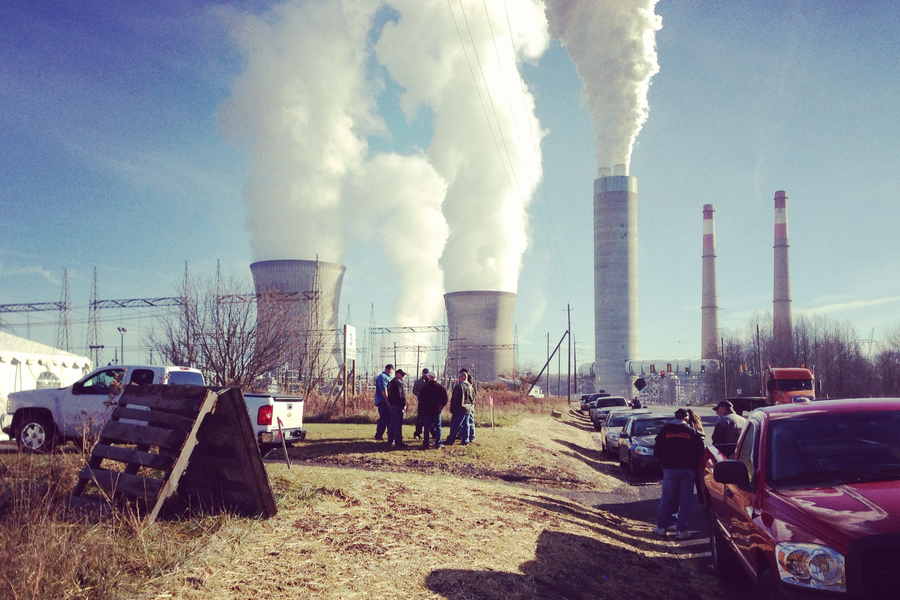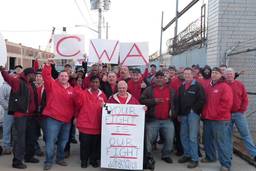This is part one of a three-part series, “Dying in the Coal Mines,” which looks at how environmental and financial imperatives are dramatically altering the coalfields while the situation for workers deteriorates.
MONGONGAHELA, PENNSYLVANIA—Just as preventable gun violence — like the Sandy Hook Elementary murders — tends to spur a brief push for gun control that often dies on the vine, mine explosions are typically followed by calls for better safety measures that rarely result in actual changes. Pennsyvania miners reflected bitterly upon this on December 6, when United Mine Workers of America (UMWA) commemorated the 50th anniversary of the 1962 Robena mine explosion, in which 37 miners were killed, with a ceremony attended by several hundred miners, retirees and their families.
“I remember it like it was yesterday,” 94-year-old retired coal miner Charles Karwatsky told Working in These Times at the ceremony. “I was shaking like this. It was my buddy that blew up. I traded [shifts] with him and I took his place because I liked the boy. He was a colored boy and the white boys were giving him a hard time so I said, ‘Sammy, if none of your buddies will trade with you then I will trade with you.’ The guy I swapped with, Sammy Rain, he blew up….That would have been me. They would have been calling my name out [at the ceremony].”
For many of the miners and for the families of those who died, the memory of the Robena explosion is still sharp. They recall the blizzard of snow that fell that day, and sleeping in tents near the mine in the nights that followed as they awaited news of the fates of the missing miners.
During the ceremony, a union official asked all the family members of the miners who were killed to come forward, and then began reading out the names of the 37 men. A gray-haired man in his mid-60s, struggling to make his way through the crowd, called out, “I am here, I am over here.” As he reached the front, he broke down and began to cry. Fifty years have passed since his father’s death, but the pain is still raw.
Even for miners who were not at the Robena mine on that day in 1962, the accident still strikes a nerve. Many miners I spoke with say they feel just as vulnerable to preventable mine explosions today as miners were 50 years ago. The Upper Big Branch explosion in 2010, which killed 29 miners in West Virginia, was strikingly similar to the Robena explosion. Both were caused by methane and coal dust igniting, a scenario that can be prevented by properly ventilating the mines and washing out coal dust. That coal dust-fueled explosions keep occuring, despite ample knowledge on how to prevent them, leads Karwatsky to wonder whether mine safety has improved at all since the explosion that killed his friend Sammy Rain 50 years ago.
“It’s just about the same. There ain’t no change,” he says.
“It’s terribly unfortunate the lessons of Robena and of earlier and later disasters were not applied in Upper Big Branch,” says J. Davitt McAteer, who served as Mine Safety and Health Administration (MSHA) director under President Clinton. “We knew in 1962 and in 2010 that in the presence of methane, coal dust can in fact ignite and start a big explosion. We disregarded all these things that happened at Robena, so we blow up 29 more guys. … We neglect the prevention because we get in a hurry to mine the product. All it requires to prevent [coal dust-fueled explosions] is ventilation and water.”
Seven years after the Robena disaster, a Farmington, W. Va. explosion that killed 78 miners finally spurred Congress to pass the 1969 Coal Mine Safety and Health Act. The act, updated in 1977, mandated safety measures such as coal-dust clean-up and instituted annual federal inspections. In the year leading up to the Upper Big Branch explosion in 2010, the mine was cited 458 times for various safety violations, including nearly 50 citations for willful violations of the law — nearly five times the national average for citations of a single mine. The MHSA proposed $1.89 million in fines from 2005 to 2010 for Upper Big Branch. Yet despite the citations, the mine stayed open.
“Following the 1969 Coal Mine Safety Act, the number and magnitude of coal dust explosions declined substantially,” says Celeste Monforton, a former Mine Safety and Health Administration official under Clinton. “In fact, the industry’s views about coal dust transformed so much so that it was well accepted throughout the industry that coal dust explosions are 100 percent preventable. When Upper Big Branch occurred — a massive coal dust explosion — it was particularly shocking because it had been at least 20 years — maybe longer — since a coal dust explosion killed US mine workers.” She continues, “The industry accepts and takes seriously — you don’t mess with the gun powder that is coal dust. Regrettably, Massey Energy [which owned Upper Big Branch] gambled for years with workers’ lives with coal dust and many other hazards. The gamblers have gotten away with murder, and the workers and their families left to suffer the consequences.”
An independent panel organized by West Virginia governor Earl Ray Tomblin later found that prior to the explosion, there were flagrant violations at Upper Big Branch, sufficient to shut down the mine. But the authorities did not catch them, in part because none of the miners reported them. Miners in Appalachia, who are desperate to keep the scarce remaining coal jobs, know that a phone call to regulators or the media to blow the whistle on safety problems could result in being fired and possibly blacklisted.
United Mine Workers of America President Cecil Roberts feels this is the reason why many miners at Upper Big Branch were willing “to keep their mouths shut.” Unionized miners have some protections, but Upper Big Branch was a non-unionized mine. While the laws, technology and knowledge to prevent mine explosions have improved dramatically since 1962, protection from retaliation for reporting those problems has not.
“Let’s face it, non-union miners don’t have the opportunity to stand up and speak out,” says Roberts. “We need protections for those miners who mostly work at non-union mines to be able to feel comfortable to report violations and problems with respect to their mines without being discharged, or disciplined, or having their jobs threatened – or their future employment, for that matter. If people had felt comfortable calling MSHA and the state to come in and examine some of these problems they were having that were pretty apparent, we may have not had Upper Big Branch.”
After I left Roberts that day, something that he said to me over breakfast stuck in my mind.
“There was a guy at Upper Big Branch who wrote a letter telling his fiancée and baby saying goodbye,” he told me. “You are not supposed to write that letter when you are going off to work, are you? You are supposed to write those letters when you go off to war, not to work.”









